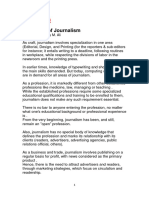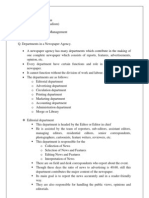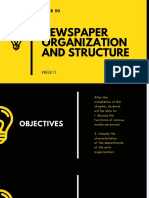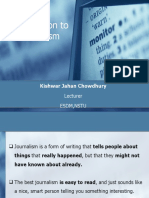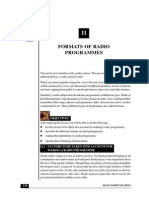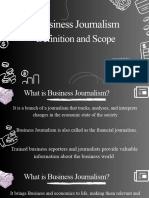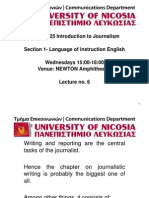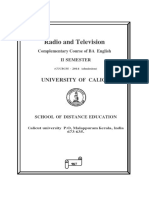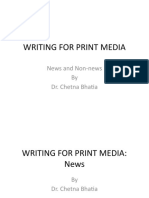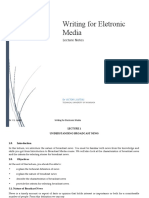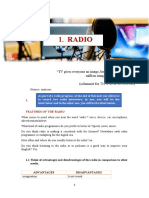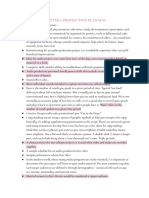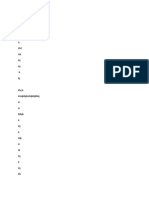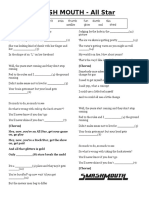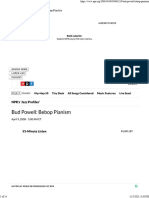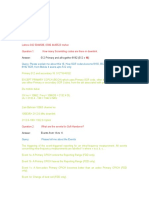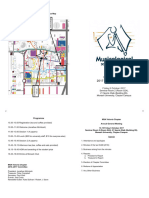Revision Icm
Uploaded by
Elvis NamulandaRevision Icm
Uploaded by
Elvis NamulandaICM REVISION QUESTIONS FOR:
Digital TV & radio Journalism
Sub- editing & design
Broadcast Journalism
Compiled by Madam Menya Silvia
@October 2024.
By Madam Menya Silvia
DIGITAL TV & RADIO JOURNALISM
QUESTION ONE
09/022
Define what is meant by each of the following terms in the journalistic context: (20 Marks)
i. Contribution circuit
ii. Fish eye
iii. Barn doors
iv. Ident
v. Shelf item
vi. Peg
vii. Pixel
viii. Popping
ix. Scoop
x. Windshield
12/022
a. Describe five tasks required in order to prepare for a television broadcast on location. Use
examples to support your description. (15 Marks)
b. State what is meant by a “risk management.” (1 Mark)
c. State four risks to safety when filming on location during a civil disturbance or natural
disaster. (4 Marks)
06/024
a. Explain what is meant by “single headed presentation” and what is meant by “double
headed presentation” on television. (2 Marks)
b. Outline each of the following types of talkback:
i. Switch (2 Marks)
ii. Open (2 Marks)
c. Outline seven considerations foe television presenters with regards to attire. (14 Marks)
By Madam Menya Silvia
09/024
a. Explain the purpose of automatic level control (ALC) in the context of digital recording.
(3 Marks)
b. Outline the challenge of using ALC. Use an example to support your answer. (3 Marks)
c. State two ways to overcome the challenge of ALC. (2 Marks)
d. Outline each of the following types of microphones: (4 Marks)
i. Gun mic
ii. Moving coil/ Dynamic mic
iii. Omni-directional mic
iv. Ribbon mic
QUESTION TWO
09/022
Explain each of the five defenses available in a defamation case. Use examples to support your
explanations. (20 Marks)
12/022
Describe the following aspects of the “five shot” technique:
i. The type of shot (20 Marks)
ii. The process of taking that shot
iii. One question to consider for the purpose of that shot
06/024
a. State five recommendations for:
i. Preparing questions for television interviews (5 Marks)
ii. Effective interview techniques (5 Marks)
e. Suggest ten questions to ask one of the following interviewees:
i. A scientist who is developing a cure for a genetic illness.
ii. A sports personality who has set a recent world sporting record.
iii. A musician who has organized a worldwide charity event. (10 Marks)
By Madam Menya Silvia
09/024
a. Describe five tasks required in order to prepare for a television broadcast on location. Use
examples to support your description. (15 Marks)
b. State what is meant by a “risk management.” (1 Mark)
c. State four risks to safety when filming on location during a civil disturbance or natural
disaster. (4 Marks)
QUESTION THREE
09/022
a. Explain the way in which automatic level control (ALC)works. (3 Marks)
b. Explain the potential challenges of automatic level control (ALC) and how these
challenges can be overcome. (5 Marks)
c. Describe the effective use of each of the following types of microphones: (12 Marks)
i. Omni mic
ii. Gun mic
iii. Moving coil
iv. Ribbon mic
12/022, Q6 09/024
a.Explain the reason conversational language is preferred when broadcasting. (3 Marks)
b. Explain the importance of writing a news script with correct punctuation. (3Marks)
c. State four rules for using numbers in writing for broadcast. (4 Marks)
d. Outline three recommendations for headline style in broadcasting. (6 Marks)
e. State the different purposes of headlines and closing heads. (2Marks)
f. State two reasons for choosing to report speech indirectly rather than directly when
broadcasting. (2 Marks)
06/024
Write a script of around 200 words containing two items of local news for a radio news reader,
using the “Five Ws” rule for bulletins. (20 Marks)
By Madam Menya Silvia
09/024
A journalist is conducting a radio interview with a musician.
a. Explain one purpose of the interview which could form the focus of questioning.
(6 Marks)
b. Suggest 14 questions the interviewer can ask the musician. (14 Marks)
QUESTION FOUR
09/022
a. Explain what is meant by single headed and double headed presentation on television.
(2 Marks)
b. Outline the two types of talkback: (4 Marks)
i. Switch
ii. Open
c. Describe the clothing rules and recommendations that television presenters must follow.
(14 Marks)
12/022
b. Define what is meant by “wildtrack”. (2 Marks)
c. Evaluate two benefits of adding background music to a TV feature. Use examples of
appropriate and inappropriate choices of music to support your evaluation. (8 Marks)
d. State what is meant by the acronym “ISDN”. (2 Marks)
e. Suggests four equipment checks a sports reporter must make on items in an outside
broadcast kit. (8 Marks)
09/024
a. State three situations in which using “fade to black” is appropriate. (3 Marks)
b. Explain what is meant by a “jump cut”. Use an example to support your explanation.
(4 Marks)
a. Explain the importance of “natural sound”. Use examples to support your explanation.
(8 Marks)
b. Explain what is meant by “timecode”, including its use in editing. (6 Marks)
By Madam Menya Silvia
QUESTION FIVE
09/022
a. Explain five tasks which must be carried out to prepare for a television broadcast on
location. Use examples to support your explanations. (15 Marks)
b. State four risks to safety when filming on location at a civil disturbance or natural disaster.
(4 Marks)
c. State what is meant by the term risk assessment. (1 Marks)
12/022
a. Explain the light differences in the image a camera captures compared to an image captured
by the human eye. (4Marks)
b. Outline the circumstances in which a new “white balance”is required. (2 Marks)
c. Explain the steps required to “white balance” a shot. (6 Marks)
d. Outline the effects created when “auto focus “is left on. (2 Marks)
e. Explain what is meant by “depth of field”, including how depth of field can be reduced.4 Mrks
f. Define what is meant by the term “pull focus”. (2 Marks)
06/024
a. There is a risk when broadcasting on live radio that people may use offensive language or
share offensive views. Describe the British Broadcasting Corporation’s (BBC) guidelines for
preventing offensive content on live radio. (10 Marks)
b. A radio presenter must keep programme timings.
i. Describe a situation that would alter programme planning whilst on air, including the
ways this situation could be managed. (5 Marks)
ii. State ways to either fill out or cut short a live proagramme. (5 Marks)
09/024
Discuss the factors to consider when selecting an appropriate location for an interview. Use
examples to support your discussion. (20 Marks)
QUESTION SIX
By Madam Menya Silvia
03/022
a. Outline what is meant by the 5Ws. Use examples of real or fictional story to support your
answer. (10 Marks)
b. Explain the use of the Christmas Tree Structure when deciding the order of presenting a
news story. Use an example of a real or fictional story to support your explanations.
(10 Marks)
09/022
a. Outline five sources of press releases and the types of news which comes from each
source. (10 Marks)
b. Describe the factors which helps determine the contents of a press bulletin. (10 Marks)
12/022
a. Suggest two items an an applicant for a TV news presenter role should include with their show
reel, including reasons for your suggestions. (4 Marks)
b. Describe considerations for creating an effective showreel. (6 Marks)
c. Discuss ways a TV presenter can prepare for a job interview. (10 Marks)
09/024
a. Explain the reason conversational language is preferred when broadcasting. (3 Marks)
b. Explain the importance of writing a news script with correct punctuation. (3Marks)
c. State four rules for using numbers in writing for broadcast. (4 Marks)
i. Outline three recommendations for headline style in broadcasting. (6 Marks)
ii. State the different purposes of headlines and closing heads. (2Marks)
d. State two reasons for choosing to report speech indirectly rather than directly when
broadcasting. (2 Marks)
06/024
a. Define what is meant by “wildtrack”. (2 Marks)
b. Evaluate two benefits of adding background music to a TV feature. Use examples of
appropriate and inappropriate choice of music to support your evaluation. (8 Marks)
c. State what the acronym “ISND” stands for. (2 Marks)
By Madam Menya Silvia
d. Suggest four equipments checks a sports reporter must make on items in an outside
broadcast kit. (8 Marks)
QUESTION SEVEN
03/022
A candidate is attending an interview for the position of News Reporter for a local radio station.
The panel has already been given details about their experience, qualifications and interests.
Describe four areas of questioning for which the candidate can prepare. (20 Marks)
09/022
a. State five recommendations for”
i. Preparing questions for TV interviews (5 Marks)
ii. Effective interview manner or techniques (5 Marks)
b.Suggest five questions to ask one of the following, including a reasons for each suggestion
A scientist who is developing a cure for a genetic illness
A sports personality who has set a new world sporting record
A musician who has organized a worldwide charity event. (10 Marks)
12/022, 06/ 024
Evaluate five advantages and five disadvantages of using serif faces. (20 Marks)
09/024
a. Explain the ways television presenters can keep their voices in good condition. Use examples
to support your explanations. (16 Marks)
b. Suggest two clothing items that should avoided when presenting television news, including the
reasons for avoiding each item. (4 Marks)
QUESTION EIGHT
03/022
a. What is meant by flash in the context of computer software including the advantages and
disadvantages? (10 Marks)
b. Explain what is meant by interactivity for online news programmes including the benefits
for both the user and the programme. (10 Marks)
By Madam Menya Silvia
09/022
c. Knowledge of foreign language is useful for people working internationally for a radio or
TV assignment. State the five most commonly languages worldwide. (5 Marks)
d. Responsible news organizations will not sent crews to war zones without Hostile
Environment and First Aid Training (HEFAT) as part of the employer’s duty of care to its
employees. Describe each element of HEAT. (10 Marks)
e. Describe the essential contents of an effective CV for a journalist seeking employment.
(5 Marks)
12/ 022, 06/024
Journalists must be aware of laws that govern their behaviors and writing. Explain guidelines for
each of the following: (20 Marks)
i. Breach o f confidence
ii. Copyright
iii. Sex offence
iv. Young people and the law
v. Contempt of Court
09/024
Discuss the historical developments in the training of broadcast journalists, referring to the
following and suing examples to support your discussion: (20 Marks)
i. Continuous professional development
ii. In-house to formal education
iii. Practical experience
iv. Technological advancement
By Madam Menya Silvia
SUB-EDITING AND DESIGN
QUESTION ONE
12/2021
Explain what is meant by each of the following terms in the context of sub-editing and designs:
i. Hard news
ii. Leader
iii. Spill
iv. Broadsheet
v. Banner
vi. Caption
vii. Leading
viii. Filler
ix. Byline
x. Blurb
03/022
Define what is meant by any five of the following terms: (20 Marks)
i. Cropping
ii. Infographics
iii. Modular design
iv. Style sheets
v. Copy tasting
vi. Plagiarism
vii. Bylines
viii. Lithography
09/022
By Madam Menya Silvia
Define what is meant by each of the following terms in the context of sub-editing
and design: (20 Marks)
i. Spot colour
ii. Perfector
iii. Descender
iv. Broadsheet
v. X-height
vi. Anchorpiece
vii. Leading
viii. Hypertext
ix. Modular design
x. Justification
09/022
Discuss the factors and design techniques to consider when creating a feature page. (20 Marks)
12/022
Explain four reasons a sub-editor will re-write an article rather than reject it. (20 Marks)
03/024
Discuss the factors and techniques that must be considered when designing a feature. (20 Marks)
06/024
Describe the purpose and method of each of the following in the context of media publications:
i. Revisioning
ii. Editionising
iii. Rejigging
06/024
Explain what is meant by each of the following terms in the context of sub-editing and design:
By Madam Menya Silvia
i. Footer
ii. Masthead
iii. Edition
iv. Kerning
v. Literals
vi. Platen
vii. Register
viii. Standfirst
ix. Banner
x. Blurb
09/024
Explain the role of a sub-editor, including examples when:
i. Casting-off
ii. Checking accuracy
QUESTION TWO
12/021
Discuss the challenges to sub-editing as a result of the digital revolution. (20 Marks)
03/022
a. Describe the changes within journalism during the transition to the pagination era,
considering the effects of workers, roles and equipments. (10 Marks)
b. Evaluate the advantages or disadvantages of the features of any two products created
after the digital revolution. (10 Marks)
09/022
Describe the typographic devices an editor can use to create interest in the publication of a
current affairs magazine. Use examples to support your description (20 Marks)
09/022
By Madam Menya Silvia
Describe the purpose and method of each of the following in the context of media publications:
iv. Revisioning
v. Editionising
vi. Rejig
12/022
Explain the rules that must be adhered to when writing the introductory paragraph to any story.
Use examples to support your explanations. (20 Marks)
03/023
Describe five sources of news that a newspaper will use to identify stories. Use examples to
support your description. (20 Marks)
03/024
Describe the editing tasks of a news sub-editor. Use example to support description. (20 Marks)
06/024
Explain the influence of different types of audience on the style of publications and websites.
Use examples of support your explanations. (20 Marks)
06/024
Explain what is meant by each of the following in the context of subediting, using an example of
each to support your explanations:
i. Breakers
ii. Indicators
iii. Special setting
09/024
Explain the rules that must be adhered to when writing the introductory paragraph to any story.
Use examples to support your explanation. (20 Marks)
By Madam Menya Silvia
QUESTION THREE
12/021
a. Explain the effects of publication style in conveying the purpose of a publication. Use
examples to support your explanations. (12 Marks)
b. Explain the way in which a publication can define its audience needs. (8 Marks)
03/022
a. Discuss the role of house styles. Use examples to support your discussion. (10 Marks)
b. Discuss the use of “master pages” and templates. (10 Marks)
09/022
Discuss the factors which must be considered when designing a successful website with both
news and entertainment content. (20 Marks)
09/022
Describe the use of the following in headline typography, using examples to support your
description: (20 Marks)
i. Shape
ii. Character count
12/022
Describe four stages in editing a picture for use in a news paper. (20 Marks)
03/023
a. Describe sources of pictures. Use examples to support your description. (14 Marks)
b. Outline the factors that will determine which pictures can be used by a picture editor.
(6 Marks)
03/024
By Madam Menya Silvia
Explain the importance of each of the following in headline writing, including examples to
support your explanation: (20 Marks)
i. Taste and decency
ii. Personal touch
iii. Time
iv. Location
06/024
a. Explain the importance of usability when designing for the World Wide Web (WWW)
in the context of sub-editing and design. (15 Marks)
b. Explain the design eliminations experience by web designers which are not experienced
by magazine designers. (5 Marks)
06/024
a. Explain what is meant by the terms caption in the context of sub-editing. Use examples to
support your explanation. (8 Marks)
b. Discuss the factors that must be considered when writing captions. (12 Marks)
09/024
a. Describe seven sources of picture. Use examples to support your description. (14 Marks)
b. Outline three factors that will determine which pictures can be used by a picture editor
(6Marks)
QUESTION FOUR
12/021
a. Describe the advances in editorial production over the last ten years. (10 Marks)
b. Describe the core duties of a sub-editor. (10 Marks)
03/022
By Madam Menya Silvia
a. Explain the ways in which visuals can be used to simplify complex details. Use examples
to support your explanations. (10 Marks)
b. Explain the importance of color and considerations for choosing colors for a publication .
(10 Marks)
09/022
Explain the use of color in different publications to create an effect on the readers and convey a
brand image. Use examples to support your explanations. (20 Marks)
09/022
a. Outline sources of feature articles. (8 Marks)
b. Explain the difference between the subbing processes on a page compared to subbing in a
newsroom. (12 Marks)
12/022
Describe five sources of news that a newspaper will use to identify stories. Use examples to
support your explanations. (20 Marks)
03/024
Describe guidelines for using each of the following aspects of language in a copy, using
examples, to support your description: (20 Marks)
i. Pronouns
ii. Tenses
iii. Verbs
iv. Qualifiers
06/ 024
Discuss the challenges to sub-editing as a result of the digital revolution. Use examples to
support your discussion. (20 Marks)
06/024
By Madam Menya Silvia
Discuss the reasons a sub-editor will reject a news story. Use examples to support your
discussion.
09/024
a. Outline the two general types of law to which newspapers must adhere to. (4 Marks)
b. Describe each of the following areas of law of which a publication must be aware:
i. Contempt of court (8 Marks)
ii. Privilege (8 Marks)
QUESTION FIVE
12/021. 06/024
Describe the following typographical considerations: (20 Marks)
i. The importance of X-height
ii. Use of serif or sans serif
iii. Optimum column width
iv. Kerning and condensing headlines
03/022
a. Outline five guidelines offered by Orwell (1946) for writing and editing. (10 Marks)
b. Outline the correct part of speech of the following words: (10 Marks)
i. Slightly
ii. Some
iii. But
iv. After
v. Beauty
09/022
a. Outline the five basic principles of editing. (10
Marks)
b. Define what is meant by each of the following types of sentence: (10 Marks)
By Madam Menya Silvia
i. Compound
ii. Complex
iii. Periodic
iv. Balanced
v. Loose
09/022
Explain what is meant by each of the following, using examples to support your explanations;
i. Breakers (7 Marks)
ii. Indicators (6 Marks)
iii. Special settings (7 Marks)
12/022
a. Outline the two general types of law to which the newspapers must adhere. (4 Mrks)
b. Describe each of the following area of the law of which a publication must be aware:
i. Contempt of court (8 Marks)
ii. Privilege (8 Marks)
03/023
Explain what is meant by an electronic newsroom. Use a diagram to support your explanation.
(20 Marks)
03/024
Describe the roles of each of the following in gathering news: (20 Marks)
i. Staff meeting
ii. Freelancers
iii. Local correspondents
iv. News agencies
06/024
By Madam Menya Silvia
Discuss each of the following types of privileges that protects free speech in newspaper
reporting:
i. Absolute privilege
ii. Qualified privilege
09/024
Explain the techniques that can be used to edit texts to ensure consistency in style and tone for a
news article. Use examples to support your explanations. (20 Marks)
QUESTION SIX
12/021
The editor of a current affairs magazine wants to update its design. Suggest a design the editor
can use including how each feature would contribute to improving the magazine and increasing
readership. (20 Marks)
03/022
a. Explain the reasons why X-height and optimal column width are important considerations
when designing a publication. (10 Marks)
b. Outline five typographical designs elements including how they are used. (10 Marks)
09/022
Explain the way to choose and present pictures on the page of a publication based on the type,
shape and intended effect of the picture. Use examples to support your explanation.(20 Marks)
09/022
Discuss five factors that must be considered when choosing pictures for a newspaper. Use
examples to support your discussion. (20 Marks)
12/022
Discuss the use of pictures in a newspaper. Use examples to support your description. (20 Mrks)
By Madam Menya Silvia
03/023
Discuss issues within headlines typography. Use examples to support your discussion. (20
Marks)
03/024
Explain four typographical devices used by a sub-editor when designing a newspaper page. Use
examples to support your explanation. (20 Marks)
06/024
A current affairs magazine requires a contemporary design. Suggest the ways each design would
contribute to improving the magazine and increasing readership, including reasons for your
suggestions. (20 Marks)
06/024
Discuss the factors to consider when using newspaper images/pictures. Use examples to support
your discussion. (20 Marks)
09/024
a. Explain what is meant by “scheming” in the context of designing pages for publication.
(4 Marks)
b. Discuss the design factors to consider when undertaking the “scheming” of pages. Use
examples to support your discussion. (16 Marks)
QUESTION SEVEN
12/021
A website is being launched to support a clothing brand.
a. Explain the challenge the clothing brand experience in gaining market share.
(10 Marks)
b. Suggest website design features that can increase ease of use. (10 Marks)
By Madam Menya Silvia
03/022
Explain the difference between the design of magazines and newspapers including the challenges
of each. (20 Marks)
09/022
a. Explain the production method each of the machines and the advantage of each: (12Mrks)
i. Letterpress
ii. Cylinder machines
iii. Perfectors
iv. Rotary machines
b. Evaluate the advantages and disadvantages of lithography and how it is used. (8 Marks)
09/022
Describe each of the following word traps, using examples of each to support your description:
i. Cliché’s (8 Marks)
ii. Vogue words (6 Marks)
iii. Technical words (6 Marks)
12/022
a. Describe five types of text errors. Use examples to support your explanations. (15Marks)
b. Outline the steps a sub-editor must take to check facts that are intended for publication.
(5 Marks)
03/023
Discuss the factors that affect the design of pages in a newspaper. Use examples to support your
discussion. (20 Marks)
03/024
Explain five reasons why a sub-editor may reject a news story. Use examples to support your
explanations. (20 Marks)
By Madam Menya Silvia
06/024
a. Explain the ways visuals can be used to simplify complex details. Use examples to
support your explanations. (10 Marks)
b. Describe four types of visuals. Use examples to support you description. (10 Marks)
06/024
Describe the elements of project features, including the role of subeditors. Use examples to
support your description. (20 Marks)
09/024
Describe the ways in which news patterns contribution to the effective design of newspapers.
Use examples to support your description. (20 Marks)
QUESTION EIGHT
12/021
a. A financial website gives stock market analysis, opinion and graphic to display different
international markets. Explain the ways in which the website can use graphics to display
data to attract readers. (14 Marks)
b. Describe the types of graphics that can be used to enhance a magazine covering
geography. (6 Marks)
03/022
a. Suggest guidelines for writing effective headlines (10 Marks)
b. Outline five key points to consider when web editing. (10 Marks)
09/022
a. Describe the effective positioning of different types of articles within a publication. Use
examples to support your description. (12 Marks)
b. Describe the process of copy tasting. (8 Marks)
By Madam Menya Silvia
09/022
Explain four reasons a sub-editor will decide to rewrite rather than to reject an article. Use
examples to support your explanation. (20 Marks)
12/022
Explain four typographical devices used by a sub-editor when designing a newspaper page. Use
examples to support your explanations. (20 Marks)
03/023
Describe the different stages of the subbing process. Use examples to support your description.
(20 Marks)
03/024
Explain the “legal traps” of which a sub-editor must be aware. Use examples to support your
explanation. (20 Marks)
06/024
Explain the ways in which a sub-editor will manage copy allocation. Use examples to support
your explanation. (20 Marks)
06/024
Explain what is meant by each of the following terms when handling texts for a newspaper
article, using an example of each to support your explanation. (20 Marks)
i. Delayed drop
ii. Using quotes
iii. Story sequence
iv. Geography
09/024
By Madam Menya Silvia
Describe the following ways to use paragraph in a story, using examples to support your
description: (20 Marks)
i. Paragraph coherence
ii. Paragraph consistency
iii. Paragraph content
iv. Paragraph function
v. Paragraph purpose
vi. Paragraph sequencing
vii. Paragraph structure
viii. Paragraph transitions
By Madam Menya Silvia
BROADCAST JOURNALISM
QUESTION ONE
1. Explain the ways to:
a. Establish the identity of the television news programme with the audience.
b. Win an audience for a television news programme.
c. Keep the audience for a television news programme. (20 Marks)
09/024
Explain the aspects that must be included in any effective news story. Use examples to support
your explanations. (20 Marks)
09/024
Describe each of the following sources of news, using examples to support your description:
(20 Marks)
a. Newsroom diary
b. Politicians
c. Reporters
d. Staged events
e. Tip-offs
06/024
Explain the aspects that must be included in any effective news story. Use examples to support
your explanations. (20 Marks)
03/024
By Madam Menya Silvia
Explain the factors that determine the order of item on a radio news programme. Use examples
to support your explanation. (20 Marks)
03/024
Discuss the essential qualities of an effective news story. Use examples to support your
discussion. (20 Marks)
09/019
Briefly explain the following terms used in digital and multi-media broadcasting: (20 Marks)
i. Acoustic screen
ii. Cross the line
iii. Scrambler
iv. Switching pause
v. Out-cue
vi. Teaser
vii. Hard news formula
viii. Bead air
ix. Handling noise
x. Capacitor mic
QUESTION TWO
Explain the ways to plan and implement an on-air interview with a national politician.
(20 Marks)
12/022
a.Explain what is meant by ‘stringe’ in the context of journalism. (4 Marks)
b.Evaluate the advantages and disadvantages of using stringers. (16Marks)
06/024
By Madam Menya Silvia
Describe the use of each of the following in the editing process, use examples to support ypur
description:
i. Cutting (10 Marks)
ii. Filling (10 Marks)
03/024
Describe the guidelines for questioning in a television interview. Use examples to support your
description. (20 Marks)
03/024
Describe the different sources of news. Use examples to support your description. (20 Marks)
09/019
Identify and briefly explain guidelines for writing in a conversational style for broadcast. Use
examples to support your answer. (20 Marks)
QUESTION THREE
Explain the ways in which programme balance can be established. (20 Marks)
12/022
Describe techniques for producing a piece of journalism designed to have impact. Use examples
to support your discussion. (20 Marks)
09/024
Describe the five types of news programme. Use examples to support your description
(20 Marks)
06/024
Explain the guidance for writing in a conversational style intended for broadcast. Use examples
to support your explanations (20 Marks)
By Madam Menya Silvia
03/024
Explain the importance of each of the following in the editing process:
i. Cutting (8 Marks)
ii. Backtiming (4 Marks)
iii. Filling (8 Marks)
03/024
Explain the factors that will determine the order of items on a radio news programme.
(20 Marks)
09/019
a. Explain the advantages of digital recorders over analogue machines. (10 Marks)
b. Imagine you are setting up a room on location for an interview. List the problems that’s
could arise with to microphone use and suggest solutions to the problems. (10 Marks)
QUESTION FOUR
a. Explain the importance of building rapport between a presenter and the audience. (11 Marks)
b.Explain the ways in which each of the following can help to help to build rapport: (9 Marks)
i. Knowing your materials
ii. Using ad-libs
iii. Having presence
09/024
a Explain the advantages of digital recorders in comparison with analogue machines.
(10 Marks)
b.Describe the challenges of using microphones when setting up a room on location for an
interview and how these challenges can be addressed. (10 Marks)
By Madam Menya Silvia
06/024
a Explain the advantages of digital recorders in comparison with analogue machines.
(10 Marks)
b.Describe the challenges of using microphones when setting up a room on location for an
interview and how these challenges can be addressed. (10 Marks)
12/022
Discuss challenges to responsible reporting that a journalist will experience. Use examples to
support your discussion. (20 Marks)
09/024
Describe the process and techniques involved in creating a 15-minute radio news bulletin. Use
examples to support your description. (20 Marks)
03/024
Explain the ways in which programme balance can be established. (20 Marks)
09/024
Explain the ways in which television news programmes can:
i. Establish their identify (6 Marks)
ii. Win an audience (7 Marks)
iii. Keep their audience (7 Marks)
09/019
a. Identify ten types of interviews undertaken by broadcast journalists. (10 Marks)
b. Choosing one of the interview types you identified in part (a):
i. Briefly explain what is meant by that type of interview. (2 Marks)
ii. Identify a situation for the type of interview you have chosen. (2 Marks)
iii. Identify six questions you could use in that interview. (6 Marks)
By Madam Menya Silvia
QUESTION FIVE
Explain the importance of building rapport with audience within broadcast journalism.
(20 Marks)
12/022
Describe two types of interviews undertaken by broadcast journalists, including the examples to
support your discussion. (20 Marks)
Examples of situations in which each interview would be used.
Questions that would be used in each types of interviews.
09/024
Describe ten processes involved in the editing/ production of a television news programme. Use
examples to support your description. (20 Marks)
06/024
Explain the criteria a produce must use to determine the order of items for a daily television
news programme. Use examples to support your explanation. (20 Marks)
03/024
Explain the guidelines for writing in a conversation al style intended for broadcast. Use examples
to support your explanation. (20 Marks)
09/022
Outline ten guidelines a journalist must follow when developing questions for a television
interview. (20 Mark)
09/019
Using examples to support your answers, describe ways you can: (20 Marks)
Cut parts of a programme when it is in danger of overrunning.
Fill time when necessary.
By Madam Menya Silvia
QUESTION SIX
Explain each of the following as sources of news for the broadcast journalist:
a. Wire services and news agencies (6 Marks)
b. News network (6 Marks)
c. Cross platform material (8 Marks)
12/022
a. Explain what is meant by term ‘a piece to camera’. (2 Marks)
b. Discuss examples of when to use a piece to camera in a television news programme. Use
examples to support your discuss. (18 Marks)
09/024
Outline ten factors which affect the length of time a camera operator must hold a shot. Use an
example for each factor to support your answer. (20 Marks)
12/024
Explain the importance of building rapport with audience within broadcast journalism.
(20 Marks)
03/024
Discuss the internal pressures on TV news reporting. (20 Marks)
09/022
Discuss the importance of the following in the editing process:
i. Cutting (8 Marks)
ii. Backtiming (4 Marks)
iii. Filling ( 8 Marks)
QUESTION SEVEN
By Madam Menya Silvia
Describe techniques journalist can use to maximize the effect of interview questions.
(20 Marks)
12/022
Discuss the importance of editing in the production of a television progamme . (20 Marks)
09/024
The presence of reporters and camera crews can ‘create news’ by heightening tensions in
difficult situations.
a. Explain the ways in which the presence of reporters and camera crew can ‘create news’.
Use examples to support your explanations. (14 Marks)
b. Suggest three ways in which reporters and camera crews can avoid creating news in
difficult. Use an example to support each suggestion. (6 Marks)
06/024
Describe each of the following categories of camera shot, using an example to support each
description:
i. The long shot (4 Marks)
ii. The medium long shot (4 Marks)
iii. The medium close-up (4 Marks)
iv. The close-up (4 Marks)
v. The big close-up (4 Marks)
03/024
Suggest the contents of a training manual about factors affecting the length of time a camera
operator must “hold a shot.” (20 Marks)
09/022
Outline ten guidelines a journalist must follow when reporting live on television. (20 Marks)
QUESTION EIGHT
Describe what is meant by each of the following terms in the context of digital and multi-media
broadcasting, using examples to support your explanations: (20 Marks)
By Madam Menya Silvia
a. Acoustic screen
b. Crossing the line
c. Scrambler
d. Switching pause
e. Outcue
12/022
Discuss the issues that must be considered when using pictures in a TV news programme.
(20 marks)
09/024
Explain ten reasons for editing a radio programme. Use an example for each reason to support
your explanation. (20 Marks)
06/024
Discuss the skills, abilities and qualities of an effective television newscaster. 20 Marks)
03/024
Explain the ways the presence of reporters and camera crew can ‘create news’ by heightening
tensions in a difficult situation, including how this can be avoided. Use examples to support your
explanations. (20 Marks)
09/022
Outline ten types of interviews. Use example to support your answer. (20 Marks)
QUESTION NINE
By Madam Menya Silvia
2. Explain the ways in which the techniques of cutting, filling and backtiming allow an
editor to ensure that a programme will run to time. Use examples to support your
explanations. (20 Marks)
09/024
1. Describe the process and techniques involved in creating a 15-minute radio news bulletin.
Use examples to support your description. (20 Marks)
2. Describe ten processes involved in the editing/ production of a television news
programme. Use examples to support your description. (20 Marks)
3. Outline ten factors which affect the length of time a camera operator must hold a shot.
Use an example for each factor to support your answer. (20 Marks)
4. The presence of reporters and camera crews can ‘create news’ by heightening tensions in
difficult situations.
c. Explain the ways in which the presence of reporters and camera crew can ‘create news’.
Use examples to support your explanations. (14 Marks)
d. Suggest three ways in which reporters and camera crews can avoid creating news in
difficult. Use an example to support each suggestion. (6 Marks)
5. Explain ten reasons for editing a radio programme. Use an example for each reason to
support your explanation. (20 Marks)
By Madam Menya Silvia
You might also like
- Broadcast Journalism: Sample Assessment MaterialNo ratings yetBroadcast Journalism: Sample Assessment Material2 pages
- Introduction To Journalism: Kishwar Jahan ChowdhuryNo ratings yetIntroduction To Journalism: Kishwar Jahan Chowdhury25 pages
- Role, Function & Qualities of A ReporterNo ratings yetRole, Function & Qualities of A Reporter25 pages
- Essential Traits for Aspiring JournalistsNo ratings yetEssential Traits for Aspiring Journalists3 pages
- Definition and Scope of Business JournalismNo ratings yetDefinition and Scope of Business Journalism6 pages
- Week 6: Journalistic Writing. Introduction100% (1)Week 6: Journalistic Writing. Introduction98 pages
- Em Unit IV Ggsipu BJMC Event Management NotesNo ratings yetEm Unit IV Ggsipu BJMC Event Management Notes44 pages
- Immediacy of Online News: Journalistic Credo Under PressureNo ratings yetImmediacy of Online News: Journalistic Credo Under Pressure24 pages
- Literature Review Construction Project ManagementNo ratings yetLiterature Review Construction Project Management8 pages
- Bajmc 6 Sem Global Media An Overview Bajmc 304 Jul 2023No ratings yetBajmc 6 Sem Global Media An Overview Bajmc 304 Jul 20231 page
- Source of News in Journalism Radio, TV, Newspapers & MagazinesNo ratings yetSource of News in Journalism Radio, TV, Newspapers & Magazines12 pages
- Writing For Electronic Media Lecture NotesNo ratings yetWriting For Electronic Media Lecture Notes80 pages
- Guidelines, Code & Ethics For PresentationNo ratings yetGuidelines, Code & Ethics For Presentation8 pages
- Subculture The Meaning of Style Dick Hebdige. - The Full Ebook Version Is Just One Click Away100% (4)Subculture The Meaning of Style Dick Hebdige. - The Full Ebook Version Is Just One Click Away75 pages
- Globalfix Ipro 406GPS - RLB-36 - OME - Y1-03-0233-JNo ratings yetGlobalfix Ipro 406GPS - RLB-36 - OME - Y1-03-0233-J43 pages
- Chapter 1 Electronic Test and MeasurementNo ratings yetChapter 1 Electronic Test and Measurement24 pages
- Nocturne - Laufey 'Bewitched' (Official Piano-Voice Sheet)No ratings yetNocturne - Laufey 'Bewitched' (Official Piano-Voice Sheet)3 pages
- NOTE - English Meaning - Cambridge DictonaryNo ratings yetNOTE - English Meaning - Cambridge Dictonary15 pages
- Sheryl Crow Feat. Sting - Always On Your SideNo ratings yetSheryl Crow Feat. Sting - Always On Your Side2 pages
- Banda Black Rio - MR Funky Samba (Sax, Trumpet Parts) 1977100% (1)Banda Black Rio - MR Funky Samba (Sax, Trumpet Parts) 19774 pages
- Musicological Society of Australia VictoNo ratings yetMusicological Society of Australia Victo6 pages
- AND Dance Music: Meter, Design ElectronicNo ratings yetAND Dance Music: Meter, Design Electronic364 pages





